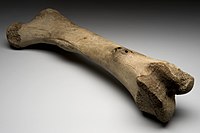
The W9 peptide inhibits osteoclastogenesis and osteoclast activity by downregulating osteoclast autophagy and promoting osteoclast apoptosis.
Sign Up to like & getrecommendations! Published in 2021 at "Journal of molecular histology"
DOI: 10.1007/s10735-021-10030-0
Abstract: The W9 peptide has been shown to act as a receptor activator for nuclear factor-κB ligand (RANKL) antagonist and tumor necrosis factor (TNF)-α antagonist, which can promote bone formation and inhibit bone resorption. Studies on… read more here.
Keywords: peptide; apoptosis; osteoclastogenesis osteoclast; osteoclast autophagy ... See more keywords

Computational modeling reveals a key role for polarized myeloid cells in controlling osteoclast activity during bone injury repair
Sign Up to like & getrecommendations! Published in 2021 at "Scientific Reports"
DOI: 10.1038/s41598-021-84888-1
Abstract: Bone-forming osteoblasts and -resorbing osteoclasts control bone injury repair, and myeloid-derived cells such as monocytes and macrophages are known to influence their behavior. However, precisely how these multiple cell types coordinate and regulate each other… read more here.
Keywords: modeling; bone; osteoclast activity; injury ... See more keywords

CYT387, a JAK-Specific Inhibitor Impedes Osteoclast Activity and Oophorectomy-Induced Osteoporosis via Modulating RANKL and ROS Signaling Pathways
Sign Up to like & getrecommendations! Published in 2022 at "Frontiers in Pharmacology"
DOI: 10.3389/fphar.2022.829862
Abstract: Osteoclasts are of hematopoietic lineage and have the ability to degrade mineralized bone tissues. Abnormalities in osteoclastic activity under certain pathological conditions are common in bone diseases such as osteoporosis, osteosclerosis, and arthritis. Although many… read more here.
Keywords: bone; osteoclast activity; inhibitor; osteoporosis ... See more keywords

Leucine Repeat Rich Kinase 1 Controls Osteoclast Activity by Managing Lysosomal Trafficking and Secretion
Sign Up to like & getrecommendations! Published in 2023 at "Biology"
DOI: 10.3390/biology12040511
Abstract: Simple Summary Osteoporosis, an age-related disease, develops in part because the rate of new bone formation does not catch up with the increased bone destruction caused by osteoclasts. A full understanding of how osteoclasts function… read more here.
Keywords: ruffled border; bone; osteoclast activity; lrrk1 deficient ... See more keywords

Quercitrin Nanocoated Implant Surfaces Reduce Osteoclast Activity In Vitro and In Vivo
Sign Up to like & getrecommendations! Published in 2018 at "International Journal of Molecular Sciences"
DOI: 10.3390/ijms19113319
Abstract: In this study, the effect on osteoclast activity in vitro and in vivo of titanium implants that were coated with quercitrin was evaluated. Titanium surfaces were covalently coated with the flavonoid quercitrin. The effect of… read more here.
Keywords: activity vitro; implant surfaces; vitro vivo; vivo ... See more keywords

Aminopropyltriethoxysilane (APTES)-Modified Nanohydroxyapatite (nHAp) Incorporated with Iron Oxide (IO) Nanoparticles Promotes Early Osteogenesis, Reduces Inflammation and Inhibits Osteoclast Activity
Sign Up to like & getrecommendations! Published in 2022 at "Materials"
DOI: 10.3390/ma15062095
Abstract: Due to its increased prevalence, osteoporosis (OP) represents a great challenge to health care systems and brings an economic burden. To overcome these issues, treatment plans that suit the need of patients should be developed.… read more here.
Keywords: nhap incorporated; osteoclast activity; activity; oxide nanoparticles ... See more keywords